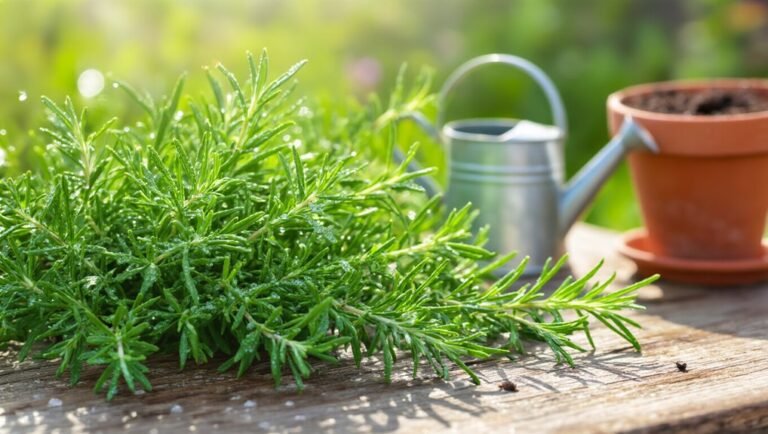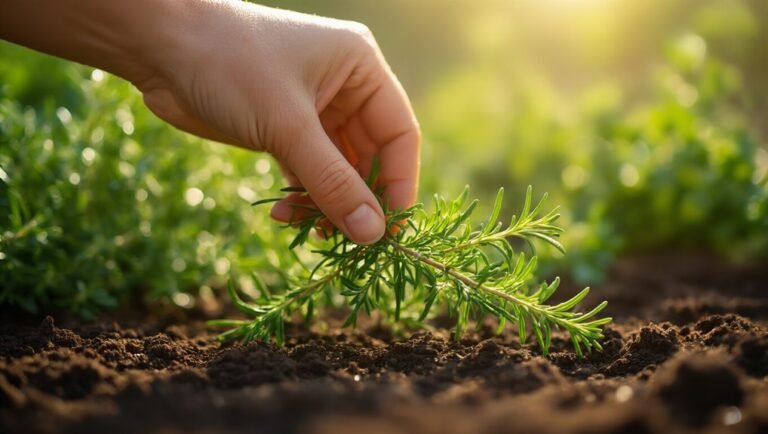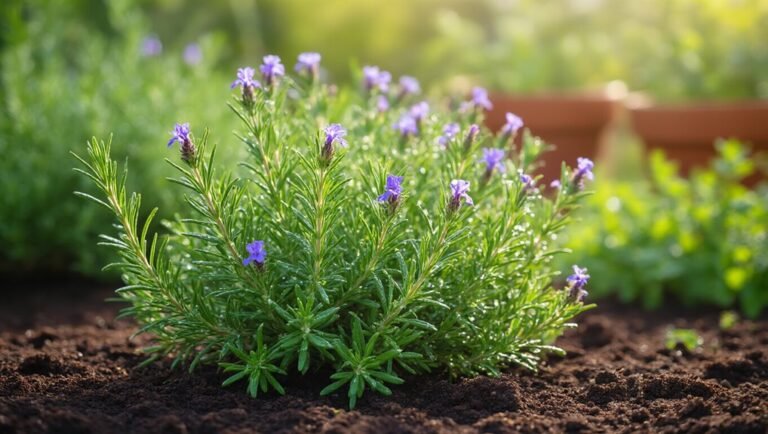To grow beautiful jasmine flowers, choose the right variety suited for your climate and fragrance preference. Ensure they get 6-8 hours of sunlight daily and maintain humidity levels. Use well-draining, fertile soil with a pH of 6.0 to 7.0. Water regularly, allowing the top inch of soil to dry between waterings, and apply balanced fertilizer every 4-6 weeks. Prune annually for better air circulation, and keep an eye out for pests and diseases. Discover even more tips ahead!
Key Takeaways
- Choose a jasmine variety suited to your climate and growth preference for optimal results.
- Ensure jasmine receives 6-8 hours of sunlight daily and maintains moderate humidity levels.
- Water regularly, keeping the soil evenly moist, and use balanced fertilizer every 4-6 weeks during the growing season.
- Prune in late winter or early spring to promote healthy growth and improve air circulation.
- Regularly inspect for pests and diseases, using appropriate treatments to maintain plant health.
Selecting the Right Jasmine Variety
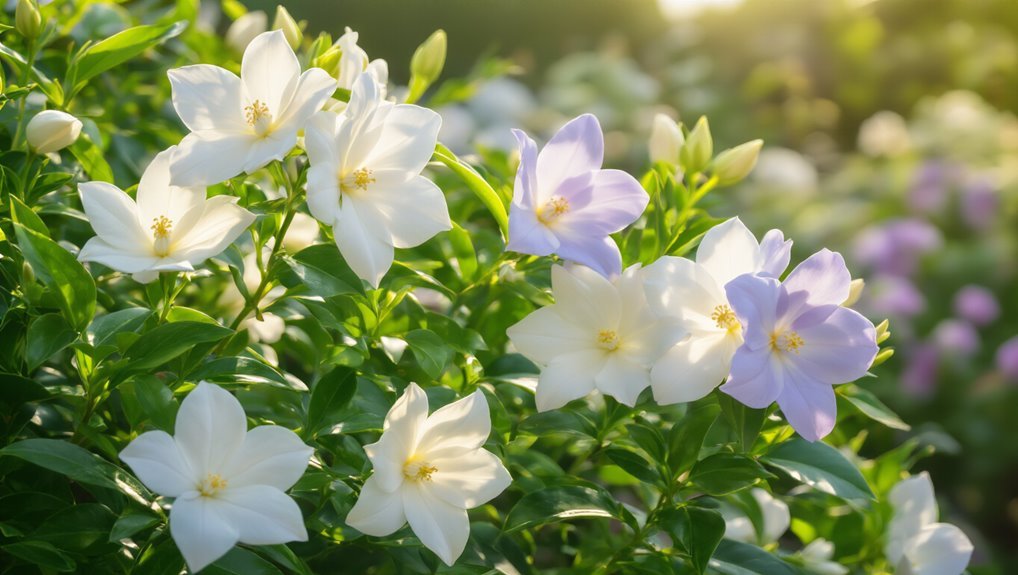
When choosing the right jasmine variety, how do you decide which one fits your garden best?
Start by considering your climate, as some jasmine types thrive in warmer conditions while others prefer cooler areas. Think about the growth habit too; do you want a climbing variety like Jasmine sambac or a bushy one like Jasmine officinale?
Next, evaluate the fragrance. Some varieties emit stronger scents than others, so pick one that matches your preference. You can also find inspiration and detailed information from gardening magazine subscriptions that feature expert reviews on different jasmine types.
Also, consider the bloom time; if you want continuous blooms, choose a variety that flowers multiple times a year.
Lastly, check for disease resistance to ensure your jasmine stays healthy. By keeping these factors in mind, you’ll select a jasmine variety that complements your garden beautifully.
For more in-depth knowledge and inspiration, consider exploring gardening books that offer expert advice on jasmine varieties and general gardening techniques.
Ideal Growing Conditions for Jasmine
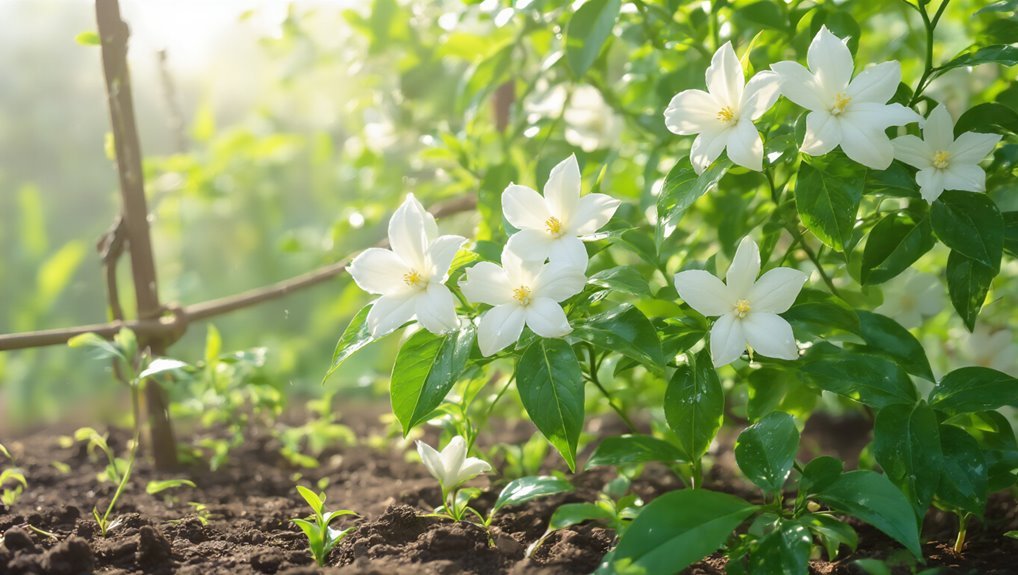
To ensure your jasmine thrives, you need to provide it with the right growing conditions. Start by placing your jasmine in a spot that gets plenty of sunlight—ideally, six to eight hours daily.
Jasmine loves warmth, so aim for temperatures between 60°F and 75°F. Make sure the humidity is moderate, as jasmine prefers a bit of moisture in the air. If you’re growing jasmine indoors, consider using a humidifier or placing a tray of water nearby. For consistent soil hydration, you might explore innovative watering systems that simplify plant care and help keep moisture levels steady.
Adequate air circulation is also essential, so avoid overcrowding your plants. Lastly, while jasmine can adapt to different environments, it thrives best when sheltered from harsh winds and extreme cold.
For optimal results, consider monitoring soil moisture levels using Soil Moisture Sensors to ensure your jasmine receives consistent and appropriate watering.
Following these tips will help your jasmine flourish beautifully.
Soil Requirements for Healthy Jasmine Plants

While jasmine can adapt to various soil types, it thrives best in well-draining, fertile soil that’s rich in organic matter.
To ensure your jasmine plants grow healthy and vibrant, focus on these key soil requirements:
- pH Level: Aim for a slightly acidic to neutral pH, ideally between 6.0 and 7.0, to promote nutrient availability.
- Organic Matter: Incorporate compost or well-rotted manure into the soil to enhance fertility and improve drainage. Adding organic mulching materials like straw can further enrich the soil and help maintain moisture levels.
- Drainage: Use sandy or loamy soil to prevent waterlogging, which can lead to root rot.
Using mulch in your garden can also help regulate soil temperature, retain moisture, and suppress weeds, all of which contribute to the overall health of jasmine plants.
Watering and Fertilization Tips
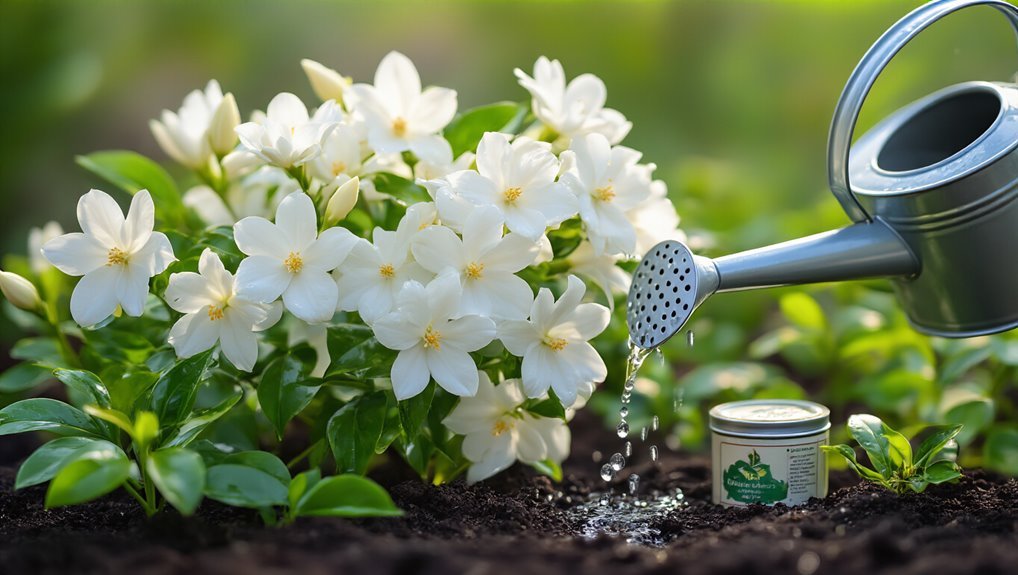
Since jasmine plants require consistent moisture to flourish, you’ll need to strike a balance in your watering routine.
Water your jasmine regularly, ensuring the soil remains evenly moist but not soggy. It’s best to check the top inch of the soil; if it feels dry, it’s time to water. During hot months, you might need to water more frequently. For gardeners seeking a convenient feeding option, plant fertilizer tablets can provide a slow-release supply of nutrients to your jasmine.
For fertilization, use a balanced, water-soluble fertilizer every four to six weeks during the growing season. This will promote healthy growth and abundant blooms.
Avoid over-fertilizing, as it can harm the plant. Always follow the package instructions for dilution.
To make fertilizing easier and more efficient, consider using fertilizer spreaders to apply plant food evenly around your jasmine.
Pruning and Maintenance Practices
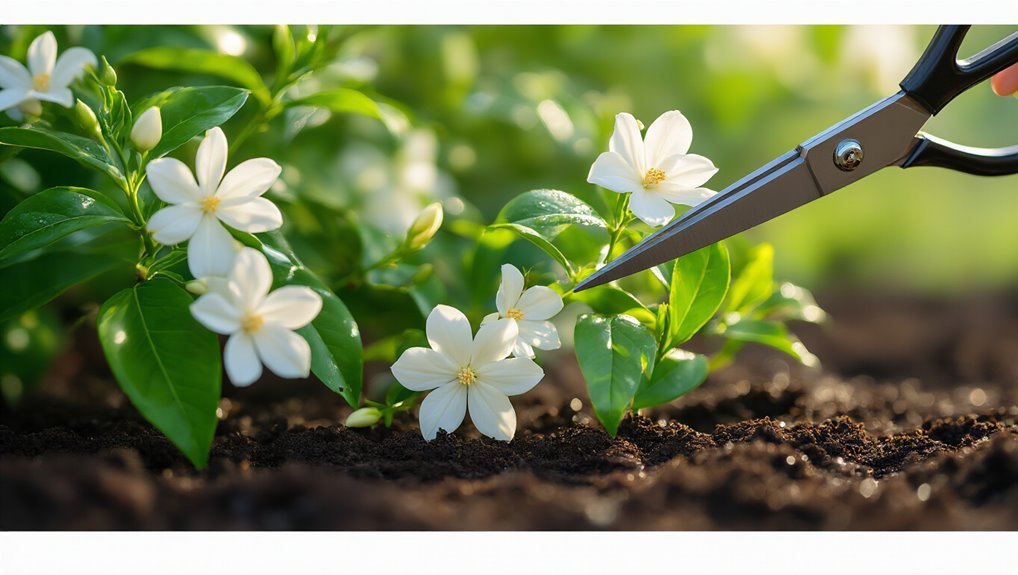
Pruning your jasmine is essential for encouraging healthy growth and ensuring a vibrant display of flowers. By regularly trimming back your plant, you promote air circulation and prevent overcrowding. To make the most of your pruning routine, it’s helpful to have a gardening tool set that includes all the basic tools you’ll need for maintaining your plants.
Here are some key practices to keep in mind:
- Timing: Prune your jasmine in late winter or early spring before new growth begins.
- Technique: Use sharp, clean shears to make clean cuts, removing dead or weak stems and encouraging new blooms.
- Frequency: Aim to prune annually, but feel free to remove any stray branches or spent flowers throughout the growing season.
For best results, choose essential pruning shears designed specifically for gardening to ensure precise and healthy cuts.
Pest and Disease Management for Jasmine
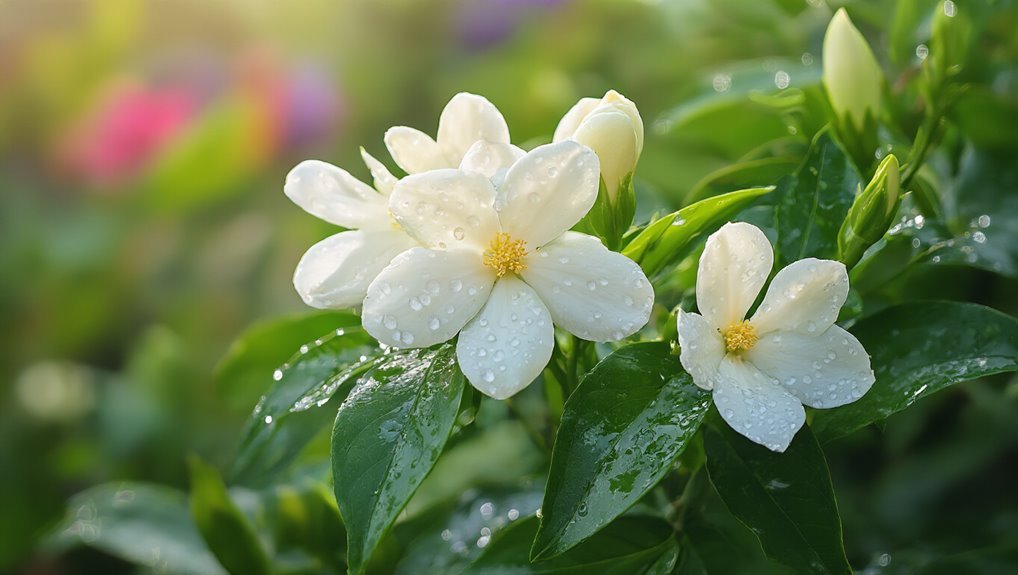
To maintain the health of your jasmine plants, it’s crucial to keep an eye out for pests and diseases that can hinder their growth.
Common pests like aphids, spider mites, and whiteflies might infest your plants, so regularly inspect leaves and stems. If you spot any, use insecticidal soap or neem oil to control them effectively. An additional option for controlling these insects is to use sticky traps, which are effective in capturing flying pests before they can damage your jasmine.
For diseases, watch for signs of powdery mildew or root rot. Ensure proper air circulation around your plants and avoid overwatering to prevent these issues.
If you notice yellowing leaves or wilting, act quickly by removing affected parts and adjusting your care routine.
To further protect your jasmine, consider using effective pest control products designed specifically for managing common garden pests.
Frequently Asked Questions
Can Jasmine Flowers Be Grown Indoors Successfully?
Yes, you can successfully grow jasmine flowers indoors! Ensure they receive plenty of bright, indirect sunlight, maintain humidity, and water them regularly. With proper care, they’ll thrive and provide beautiful fragrance in your home.
How Long Does It Take for Jasmine to Bloom?
Like waiting for a star to shine, jasmine typically takes about three to five years to bloom. If you nurture it well, you’ll soon enjoy those fragrant blossoms that make your garden enchanting!
Are Jasmine Flowers Toxic to Pets?
Jasmine flowers aren’t toxic to pets, so you don’t need to worry about your furry friends getting hurt. However, it’s always good to monitor their behavior around any plants, just to be safe.
What Are the Best Companion Plants for Jasmine?
When choosing companion plants for jasmine, consider lavender, rosemary, or marigolds. These plants not only complement jasmine’s beauty but also help attract beneficial insects, enhancing your garden’s overall health and aesthetics.
How Can I Propagate Jasmine Plants Easily?
To propagate jasmine plants easily, you can take stem cuttings during spring or summer. Ensure each cutting has a few leaves, then place them in water or soil, keeping the environment warm and humid.
Conclusion
Growing jasmine can seem daunting, but with the right approach, it’s totally manageable. By selecting the right variety and providing ideal conditions, you’ll set your plants up for success. Sure, you might worry about pests or diseases, but with proper management and maintenance, you’ll keep your jasmine thriving. So don’t hesitate—embrace the beauty and fragrance of jasmine in your garden. With a little care, you’ll enjoy a stunning display that enhances any space.
